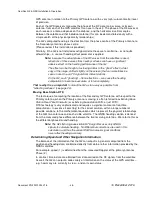
ComNav G2 & G2B Installation & Operation
Document PN 29010093 V1.5
- 45 -
16 December 2016
GPS antenna in relation to the Primary GPS antenna, with a very high (sub-centimetre) level
of precision.
Each of the GPS receivers measures the phase of the RF signal carrier wave, at its own
antenna, from each of the GPS satellites it can see in the sky. The phase of the RF waves at
each receiver’s antenna depends on the distance, and the horizontal & vertical angles,
between the satellite and that individual antenna (this can be demonstrated easily with a
simple sketch of the physical geometry relationships).
The G2’s computed heading is the direction from the phase centre of the Primary antenna to
the Secondary antenna’s phase centre.
(Please review if this installation is provided)
Similarly, if the G2 is not installed exactly parallel to the vessel’s centreline – or not quite
athwartships – a user-set heading offset parameter is applied.
Note:
because the actual phase of the RF waves from the satellites is used,
reflections of those waves from nearby surfaces can have a significant
adverse effect on the heading performance of the G2
The effect can be thought of as being similar to the “ghost” effect (a faint
copy of the image, shifted slightly on the screen) that can sometimes be
seen on over-the-air TV signals from distant stations.
On the G2, such “ghosting” – from reflections – can cause the heading
computation to become inaccurate, or to fail completely.
That is why it is so important
to mount the G2 as far away as possible from
“reflecting surfaces” (see page 20).
Moving Base Station RTK
The technique of computing the location of the Secondary GPS antenna with respect to the
Primary antenna, when the Primary antenna is moving, is often referred to as
Moving Base
Station Real-Time Kinematic
(or as
Moving-base-station RTK
, or just
RTK
).
RTK technology is very sophisticated and requires a significant amount of real-time
computation – in essence “searching” for the correct solution, within a large number of
possible solutions, to the mathematical equations which represent the physical relationships
of the G2’s two antennae and each visible satellite. The GNSS heading solution is derived
from the measured phase difference between the two receiving antennas. We refer to this as
the differential phase derived heading.
Note
: The G2’s Moving-base-station RTK algorithm uses only GNSS
signals to calculate heading. No Differential corrections are used in this
calculation, and thus the current DGPS source & signal conditions
never affect heading accuracy.
Determining Speed and Other Navigation Information
The balance of the information that the G2 can output is in general computed from the
position and heading data, or obtained directly from data or other information provided by the
GNSS satellites.
For example, speed (1) is determined from the measured Doppler of the primary antennas
Phase (2)
In contrast, time & date are obtained from data carried on the RF signals from the satellites.
As well, the G2 can output a wide variety of information on the status of the GPS satellites –
e.g., how many are currently in view – and on its own status.
Содержание Vector G2
Страница 2: ......
Страница 6: ...ComNav G2 G2B Installation Operation Document PN 29010093 V1 5 4 16 December 2016...
Страница 12: ...ComNav G2 G2B Installation Operation Document PN 29010093 V1 5 10 16 December 2016...
Страница 13: ...ComNav G2 G2B Installation Operation Document PN 29010093 V1 5 11 16 December 2016 Introduction...
Страница 14: ...ComNav G2 G2B Installation Operation Document PN 29010093 V1 5 12 16 December 2016...
Страница 18: ...ComNav G2 G2B Installation Operation Document PN 29010093 V1 5 16 16 December 2016 Installation...
Страница 19: ...ComNav G2 G2B Installation Operation Document PN 29010093 V1 5 17 16 December 2016...
Страница 43: ...ComNav G2 G2B Installation Operation Document PN 29010093 V1 5 41 16 December 2016 Operation...
Страница 44: ...ComNav G2 G2B Installation Operation Document PN 29010093 V1 5 42 16 December 2016...
Страница 58: ...ComNav G2 G2B Installation Operation Document PN 29010093 V1 5 56 16 December 2016 Care Maintenance...
Страница 59: ...ComNav G2 G2B Installation Operation Document PN 29010093 V1 5 57 16 December 2016...
Страница 61: ...ComNav G2 G2B Installation Operation Appendices Document PN 29010093 V1 5 59 16 December 2016 Appendices...
Страница 75: ...ComNav G2 G2B Installation Operation CE Compliance Statement Document PN 29010093 V1 5 73 16 December 2016...
Страница 83: ...ComNav G3 G3B Installation Operation Document PN 29010093 V1 5 81 16 December 2016...
Страница 84: ...ComNav G3 G3B Installation Operation Document PN 29010093 V1 5 82 16 December 2016 Index...
Страница 85: ...ComNav G3 G3B Installation Operation Document PN 29010093 V1 5 83 16 December 2016...
Страница 87: ...ComNav G2 G2B Installation Operation Document PN 29010093 V1 5 85 16 December 2016...
Страница 88: ...ComNav G2 G2B Installation Operation Document PN 29010093 V1 5 86 16 December 2016 User Notes...
Страница 89: ...ComNav G2 G2B Installation Operation Document PN 29010093 V1 5 87 16 December 2016...
Страница 92: ...ComNav G2 G2B Installation Operation User Notes Document PN 29010093 V1 5 90 16 December 2016 Notes...






























